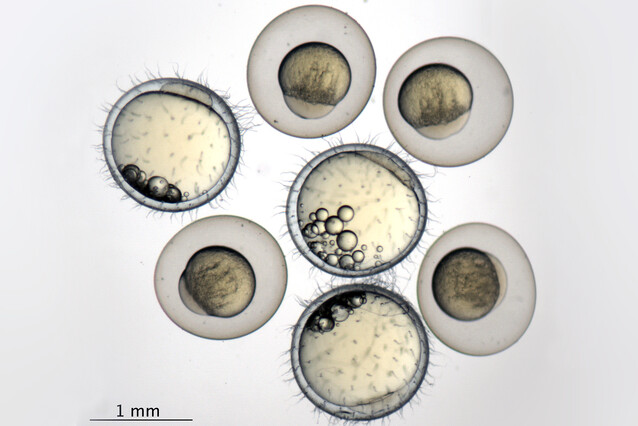Sperm-egg matchmaker "Bouncer" may drive fish evolution

In order to fertilise an egg, sperm needs to be compatible with it. A few years ago, scientists from the lab of Andrea Pauli discovered that the membrane protein Bouncer prevents cross-fertilisation between different species of fish. Building on this, they now show that Bouncer has molecular characteristics that diverge across different fish species – hinting at a role it could play in driving evolution.
The right fit between an egg and a sperm is required for successful fertilisation. The biggest group of vertebrates are bony fish, in which fertilisation occurs outside of the body: fish release both eggs and sperm into the water. Such a situation requires especially robust mechanisms to prevent cross-fertilisation between different species.
In 2018, scientists from the lab of Andrea Pauli discovered that a protein on the membrane of fish eggs was responsible for determining the sperm-egg match in two species of fish, medaka and zebrafish (Herberg et al., 2018). The two species diverged around 200 million years ago and cannot cross-fertilise due to the membrane protein preventing entry of the other species' sperm. True to its role, the scientists named the fertilisation protein "Bouncer". They showed that if medaka Bouncer is expressed on the egg of zebrafish, it allows medaka sperm to enter the zebrafish egg – and vice versa in another study currently posted on bioRxiv (Gert et al., 2021).

In a new study published in the journal Nature Communications, the researchers now identified more details on the mechanism by which Bouncer determines a sperm-egg fit. Looking within Bouncer, the scientists found a medaka-specific change in the DNA sequence that encodes an amino acid different from other fish species. This change creates a barrier for other species' sperm to successfully interact with the egg. The study also uncovered that medaka Bouncer requires a certain modification – the addition of the sugar N-glycose – to make it compatible with medaka sperm.
Medaka Bouncer is very similar to that of two other, less closely related fish species examined: fugu (known for its poison and famed appearance in Japanese cuisine) and seahorses. In spite of this similarity, the scientists showed that Bouncer in these species did not prevent zebrafish sperm from entering eggs.
"Bouncer seems to be at the centre of a fascinating evolutionary tug-of-war," says Andrea Pauli, IMP Senior Group Leader. "Some species appear to require distinct molecular elements in Bouncer for sperm compatibility, while in others, the Bouncer-sperm interaction is less stringent, allowing hybridization between more distantly related species." The findings highlight that Bouncer has a special position within the sperm-egg interaction machinery.

"As the primary sperm-binding molecule on the egg, Bouncer determines which sperm can interact and fuse with the egg. The features we discovered in Bouncer determine the flexibility versus specificity of sperm-egg interaction," says Krista Gert, a Vienna BioCenter PhD student and first author of the study. "This is how Bouncer influences the ability of species to hybridise with each other. We think this could have been instrumental in making fish so numerous and diverse over the course of evolution." In particular, the freshwater fish group of cyprinids, which includes zebrafish, has high rates of hybridisation. On the molecular level, this is likely due to their similar Bouncer proteins and lower specificity for successful sperm interaction.
"Medaka, on the other hand, can hybridise only with other members of the same genus. We think Bouncer must play a central role here, but it is only one side of the story," says Gert. "What Bouncer binds on sperm is still an open question, and it will be exciting to see how this factor has evolved with Bouncer to define the boundaries of cross-fertilisation."
Original publication
Krista R.B. Gert, Karin Panser, Joachim Surm, Benjamin S. Steinmetz, Alexander Schleiffer, Luca Jovine, Yehu Moran, Fyodor Kondrashov, and Andrea Pauli (2023): "Divergent molecular signatures in fish Bouncer proteins define cross-fertilization boundaries." Nature Communications, DOI: 10.1038/s41467-023-39317-4
About the Vienna BioCenter PhD Program
Much of the work underlying this publication was done by doctoral students of the Vienna BioCenter PhD Program. Are you interested in a world-class career in molecular biology? Find out more: https://training.vbc.ac.at/phd-program/
About the IMP at the Vienna BioCenter
The Research Institute of Molecular Pathology (IMP) in Vienna is a basic life science research institute largely sponsored by Boehringer Ingelheim. With over 200 scientists from 40 countries, the IMP is committed to scientific discovery of fundamental molecular and cellular mechanisms underlying complex biological phenomena. The IMP is part of the Vienna BioCenter, one of Europe’s most dynamic life science hubs with 2,900 people from over 80 countries in six research institutions, two universities, and 40 biotech companies. www.imp.ac.at, www.viennabiocenter.org